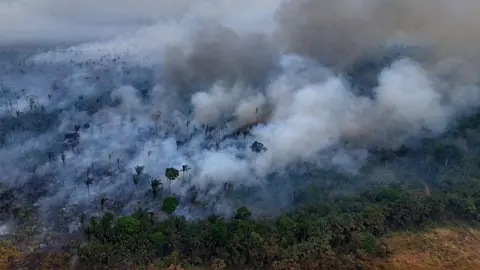BBC climate and science
 Getty images
Getty imagesThe tropical forests of the world, which provide a crucial stamp against climate change, disappeared faster than ever recorded last year, suggests a new satellite analysis.
The researchers estimate that 67,000 km2 (26,000 m²) of these virgin and old forests were lost in 2024 – an area almost as large as the Republic of Ireland, or 18 football fields per minute.
Fires were the main cause, going beyond the release of agriculture land for the first time recorded, the Amazon arguing particularly badly in the middle of the record drought.
However, there were more positive news in Southeast Asia, however, government policies helping to reduce the loss of forest.
Tropical forests slow hundreds of billions of tons of carbon in soils and woody trunks. But this new world record raises other questions about their resilience on a warming planet.
Many researchers concern certain forests, such as certain parts of the Amazon, could approach a “tilting point”, beyond which they could fall into an irreversible decline.
“The idea of the tilting point is, I think, more and more good,” said Professor Matthew Hansen, co -director of Glad Laboratory at the University of Maryland, who produces the data.
Professor Hansen described the new results as “frightening”, and warned against the possible “savannization” of the tropical forest, where the old -fashioned tropical forests died and continuously passed to the savannah.
“It’s always a theory, but I think it’s more and more plausible by looking at the data.”
A separate study, published last week, made a similar warning of a possible significant decline of the Amazon if global warming exceeds the international objective of 1.5 ° C.
This would not only threaten the dynamic range of wildlife living in these habitats most biodiversity, but also would have serious ramifications for the world climate.
Until recently, the Amazon did service to humanity, absorbing more carbon dioxide warming the planet (CO2) than it released.
But the fire of these forests emits enormous amounts of CO2 – adding to warming rather than limiting.
In 2023-24, the Amazon experienced its worst drought never recorded, fueled by climate change and the natural meteorological model of El Niño.
Many fires are deliberately launched to eliminate land for agriculture, which makes it difficult to disentangle the two.
But drought provided ideal conditions for fires to spread out of control, Brazil and the most seriously affected Bolivia.
Although only one year, it corresponds to the expected model of more intense tropical lights in a warming world.
“I think we are in a new phase, where it is not only the clearing of agriculture which is the main engine,” said Rod Taylor of the World Resources Institute (WRI), which is also behind the last report.
“Now we have this new amplification effect, which is a real climate change feedback loop, where fires are simply more intense and much more ferocious than they have ever been.”
In total, the record loss of the world’s (primary) tropical forests in the world published 3.1 billion tonnes of warming gas, according to researchers.
It is almost the same as the emissions of the European Union.
Signs of progress
However, the countries of Southeast Asia have reversed the global trend.
The area of the loss of primary forest in Indonesia dropped 11% compared to 2023, for example, despite the drought conditions.
It was the result of a concerted effort of governments and communities working together to enforce the laws “without burning”, according to Elizabeth Goldman, co -director of the Global Forest Watch Project at WRI.
“Indonesia serves as a light point in the 2024 data,” she said.
“Political will is a key factor in success – it is impossible otherwise,” said Gabriel Labbate, responsible for the attenuation of climate change on the United Nations Forests program, which was not involved in today’s report.
Other countries, including Brazil, have been successful in the past with similar approaches, but began to see the losses increase in 2014 following a change in government policies.
Professor Hansen said that although progress in Southeast Asia is positive, fluctuations in forestry loss in Brazil show that protection policies must be consistent.
“The key that we have not yet seen is the success of reducing and maintaining low conversion levels of these ecosystems and if you were interested in keeping the environment, you must always win and forever,” he told BBC News.
Researchers agree that the United Nations Climate Summit this year – which is hosted in the Amazon – will be essential to share and promote forest protection patterns.
A proposal is to reward countries that maintain tropical forests through payments. Details must still be developed but is promising, according to Rod Taylor.
“I think it is an example of innovation that addresses one of the fundamental questions which, for the moment, there is more money to make by cutting forests than to keep them standing,” he said.
Graphics by Erwan Rivault



